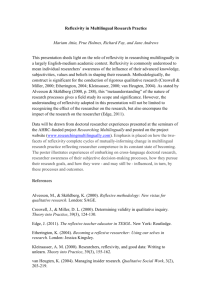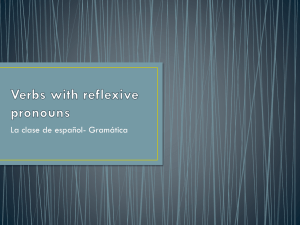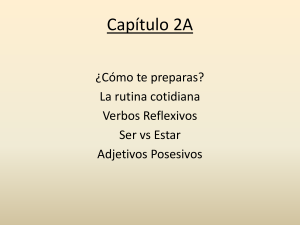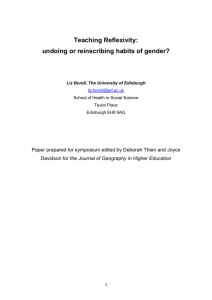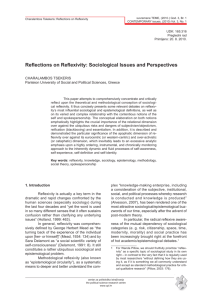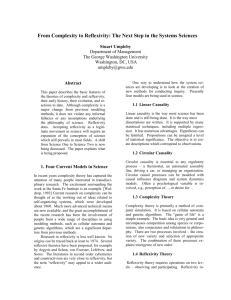Kathyrn Haynes slides - British Academy of Management
advertisement
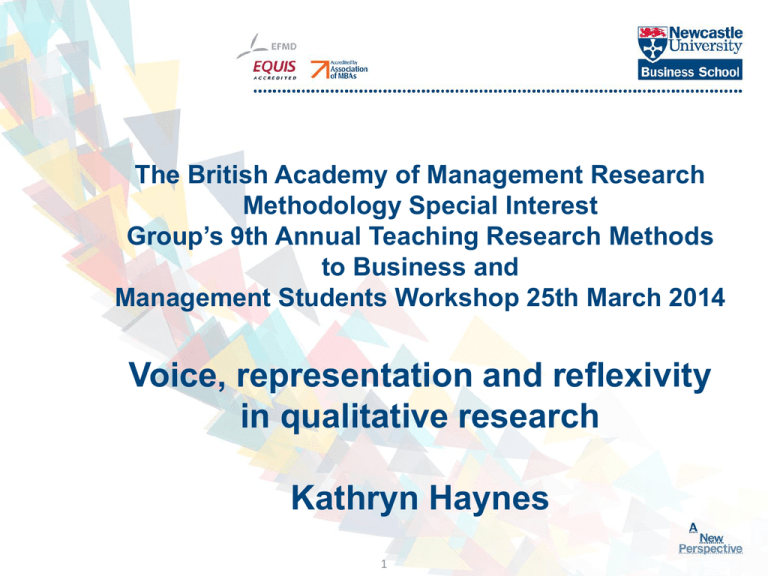
The British Academy of Management Research Click to edit Master title style Methodology Special Interest Group’s 9th Annual Teaching Research Methods to Business and Management Students Workshop 25th March 2014 Voice, representation and reflexivity in qualitative research Kathryn Haynes 1 Student research projects • “What is your motivation for this research?” – UG dissertation proposal. – Do-able – Interesting – Availability of data – Career aspirations • PhD students – Often related to experience 2 Click The to elephant edit Master in thetitle room? style 3 Click WHERE to edit ARE Master YOU title IN THE style RESEARCH? 4 Methods and research question relationship • • • • • • • • Ethnography Autoethnography Narrative SenseOral history making Storytelling Interviews Visual methods Performance Participant observation 5 Meaning Experience Emotion Voice and representation • Voice of researcher? • Voice of participants? • How to represent the researcher’s self in the research? • How to represent the participants in the research? • How do these influence each other? 6 Experimentation with voice and representation • How do you write yourself into research? – Readings: – Autoethnography (Haynes, 2011; Learmonth & Humphreys 2012) – vignettes, ‘fictive’ accounts – Watson (2000) ‘Ethnographic fiction science’ – composites, characters, dialogues – Visual images – Poems (e.g. Spry 2001) 7 The nature of autoethnographical research • Autoethnography - genre of reflexive autobiographical writing which connects the personal to the cultural by analysing the self within a social context (Reed-Danahay, 1997) • Positioning the researcher as source of reflexive intellectual inquiry • Encapsulates a personal, intuitive knowledge, deriving from a knowing subject situated in a specific social context • Allows dialogical inquiry of both the self as other and the self in relation to theory 8 Spry, Tami. "Performing Autoethnography: An embodied methodological praxis", Qualitative Inquiry, Vol. 7, No. 6, 2001, pp. 706 - 732. Being here and being there: “There is danger here in this world, The Academy, as it conferences in the gilded plastic of the luxury hotel; And in spite of myself, my shadow selves can still be seduced by its empty opulence, even when it feels like an unkind, disembodied, scriptocentric, technocratic consumer of knowledge”. 9 Reflexivity • Awareness of the researcher’s role in the practice of research, process and outcomes of research. • Awareness that the researcher and the object of study affect each other mutually and continually in the research process (Alvesson and Skoldburg, 2000) • Researcher reflexivity involves thinking about how our thinking came to be, how pre-existing understanding is constantly revised in the light of new understandings, and how this in turn affects our research. 10 Going beyond reflection • Reflection suggests a mirror image which affords the opportunity to engage in an observation or examination of our ways of doing, or observing our own practice, whereas reflexivity is more complex, involving thinking about our experiences and questioning our ways of doing (Hibbert, Coupland and MacIntosh,2010). • Alvesson and Skoldburg (2000) suggest there are two key elements embedded within reflexive research – interpretation and reflection. The interpretive element recognises that interpretation is not just based on a simple analysis of facts or data, which reflects some kind of ‘reality’; instead it is aware that interpretation is influenced by the assumptions of the researcher doing the research, their values, political position, use of language. 11 Reflexive interactions Production of knowledge (epistemology) Involvement and impact of knowledge producer (ontology) Processes of knowledge production (methodology) 12 Doing reflexive research • Interpretations and theoretical assumptions of the researcher are not neutral but are part of and help to construct perceptions of reality • Critical reflection, concerning issues of a researcher’s assumptions, interpretations and interactions are essential for practical outcomes • Reflexivity is an essential part of the research process 13 Reflexivity in practice • What is the motivation for undertaking this research? • What underlying assumptions I am bringing to it? • How am I connected to the research, theoretically, experientially, emotionally? • What effect will this have on my approach? 14 Strategies for reflexive awareness • Write down theoretical assumptions and presuppositions about the subject of the research and revisit these throughout the research process, noting how they may have shifted • Consider if or how this has revised the research question, focus or findings • Keep a research diary noting down thoughts and feelings about the research process • Keep fieldwork notes of observations, interactions, incidents, conversations, emotions and responses • Listen to tape recordings, or watch video clips, of your qualitative data gathering noting how your presence or interaction as the researcher affected the process • Discuss and evaluate responses to the research subject, 15 Multiple levels of reflexivity theoretical • Theoretical - our theoretical assumptions and understandings will be revised by the new understandings gained during the process of research, which then go on to inform new theoretical knowledge. This is what has been termed a ‘double hermeneutic’ or the interpretation of interpreting subjects (Giddens, 1976 cited in Alvesson & Skoldburg, 2000, p. 247). 16 Methodological reflexivity • Methodological position and detailed methods may be revised as researchers engage reflexively with the research process. By considering the effectiveness, conduct and process of data collection, researchers may reinterpret and revise their methodological position to take account of such issues as ethics, power relations, or use of language. 17 Ontological reflexivity • All of us as researchers have our own ontological position, comprising our perception of the nature of reality, our sense of reality, or the way we see the world. A reflexive research approach engages with our ontological position, our values and choices. As Calás & Smircich (1999, p. 664) argue: “Whether we are involved in ethnography, or heavy statistics research, whether we are writing about institutional theory, population ecology, organizational justice corporate mergers – whatever, no matter what topic or area or what methods we use – we are all… picking and choosing to pay attention and ignore … excluding, including, concealing, favoring some people, some topics, some questions, some forms of representation, some values. Can we do our writing in a way that is ‘self-conscious’ of our choices?” 18 Emotional reflexivity • Emotion is also a valuable source of reflexive insight (researcher and participant) • The emotionalization of reflexivity refers to the process whereby individuals are increasingly drawing on emotions in assessing themselves and their lives, recognising that emotions are crucial to how the social is reproduced and endured within a complex social world • Recognises the strong relationship between the process of research and the resultant product 19 Cultural, social, political reflexivity • Reflexivity is also about understanding the relationship between individual practice and social structure, recognising the part that selves play in constructing social structures as well as being mediated by them • The very cultural, social and political discourse of the subject being researched, could affect the way that the researcher treats and analyses the data derived on that subject 20 Subjective reflexivity • Researcher may effectively be both subject and object of the research • We may experience the tension of working between the dualities of public social knowledge and private lived experience • How to maintain a reflexive awareness of our shifting sense of self as both subject and object of the research, of belonging to the research and being outside it? • Is distinction between subject and object meaningful, given that it can be argued reality is constructed inter-subjectively through the process of research and does not represent some pre-defined existing reality or ‘truth’. 21 Click to edit Master title style Voice Reflexivities Representation 22 Some recent methodological work • Haynes, K. (2006), "Linking Narrative and Identity Construction: Using Autobiography in Accounting Research", Critical Perspectives on Accounting, Vol. 17 No. 4, pp. 399 - 418. • Haynes K (2010) Other Lives in Accounting: Critical Reflections on Oral History Methodology in Action. Critical Perspectives on Accounting 21(3): 221 - 231. • Haynes K (2011) Tensions in (re)presenting the self in reflexive autoethnographical research. Qualitative Research in Organizations and Management 6(2): 134 - 149. • Haynes K (2012) Reflexivity. In: Cassell C and Symon G (eds) The Practice of Qualitative Organizational Research: Core Methods and Current Challenges. London: Sage. • Haynes K (2013) Sexuality and sexual symbolism as processes of gendered identity formation: An autoethnography of an accounting firm. Accounting, Auditing & Accountability Journal 26(3): 374 - 398. 23 Further references 1 • Alvesson M and Skoldburg K (2000) Reflexive Methodology. London: Sage. • Brown, A. D. (2006), "A Narrative Approach to Collective Identities", Journal of Management Studies, Vol. 43 No. 4, pp. 731 - 753. • Calas M and Smircich L (1999) Past Postmodernism? Reflections and Tentative Directions. Academy of Management Review 24(4): 649 - 671. • Cohen, L., Duberley, J. and Musson, G. (2009), "Work-Life Balance?: An Autoethnographic Exploration of Everyday Home—Work Dynamics ", Journal of Management Inquiry, Vol. 18 No. 3, pp. 229-241. • Cunliffe, A. and Coupland, C. (2012), "From hero to villain to hero: Making experience sensible through embodied narrative sensemaking ", Human Relations, Vol. 61 No. 1, pp. 63 - 88. • Cunliffe, A. L. (2010) Why complicate a done deal? Bringing reflexivity into management research. In C. Cassell & B. Lee (Eds.) Management Research: Challenges and Controversies. London: Routledge (pp. 404-418). • Cunliffe A (2003) Reflexive Inquiry in Organizational Research: Questions and Possibilities. Human Relations 56(8): 983 24 - 1003 Further references 2 • Doloriert, C. and Sambrook, S. (2009), "Ethical confessions of the "I" of autoethnography: the student's dilemma", Qualitative Research in Organizations and Management, Vol. 4 No. 1, pp. 27 - 45. • Hibbert P, Coupland C and MacIntosh R (2010) Reflexivity: recursion and relationality in organizational research processes. Qualitative Research in Organizations and Management: An International Journal 5(1): 47 - 62. • Johnson P and Duberley J (2003) Reflexivity in Management Research. Journal of Management Studies 40(5): 1279 - 1303. • Learmonth, M. and Humphreys, M. (2012), "Autoethnography and academic identity: glimpsing business school doppelgangers", Organization, Vol. 19 No. 1, pp. 99-117. • Spry T (2001) Performing Autoethnography: An embodied methodological praxis. Qualitative Inquiry 7(6): 706 - 732. • Watson, T. J. (2000), "Ethnographic Fiction Science: Making Sense of Managerial Work and Organizational Research Processes with Caroline and Terry", 25

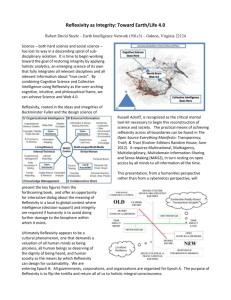
![Reflexivity in Academic Research [.PPT]](http://s2.studylib.net/store/data/005467615_1-5f1ed51efa2e2c6daa464b130d515ef6-300x300.png)
